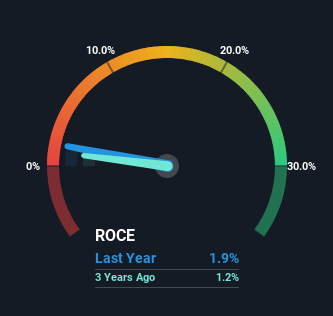Did you know there are some financial metrics that can provide clues of a potential multi-bagger? Ideally, a business will show two trends; firstly a growing return on capital employed (ROCE) and secondly, an increasing amount of capital employed. This shows us that it's a compounding machine, able to continually reinvest its earnings back into the business and generate higher returns. Having said that, from a first glance at Hing Yip Holdings (HKG:132) we aren't jumping out of our chairs at how returns are trending, but let's have a deeper look.
Understanding Return On Capital Employed (ROCE)
Just to clarify if you're unsure, ROCE is a metric for evaluating how much pre-tax income (in percentage terms) a company earns on the capital invested in its business. Analysts use this formula to calculate it for Hing Yip Holdings:
Return on Capital Employed = Earnings Before Interest and Tax (EBIT) ÷ (Total Assets - Current Liabilities)
0.019 = HK$102m ÷ (HK$9.8b - HK$4.3b) (Based on the trailing twelve months to December 2023).
Therefore, Hing Yip Holdings has an ROCE of 1.9%. In absolute terms, that's a low return and it also under-performs the Hospitality industry average of 6.1%.
Check out our latest analysis for Hing Yip Holdings

Historical performance is a great place to start when researching a stock so above you can see the gauge for Hing Yip Holdings' ROCE against it's prior returns. If you're interested in investigating Hing Yip Holdings' past further, check out this free graph covering Hing Yip Holdings' past earnings, revenue and cash flow.
How Are Returns Trending?
In terms of Hing Yip Holdings' historical ROCE trend, it doesn't exactly demand attention. The company has employed 163% more capital in the last five years, and the returns on that capital have remained stable at 1.9%. This poor ROCE doesn't inspire confidence right now, and with the increase in capital employed, it's evident that the business isn't deploying the funds into high return investments.
On a side note, Hing Yip Holdings' current liabilities are still rather high at 44% of total assets. This can bring about some risks because the company is basically operating with a rather large reliance on its suppliers or other sorts of short-term creditors. Ideally we'd like to see this reduce as that would mean fewer obligations bearing risks.
The Bottom Line
As we've seen above, Hing Yip Holdings' returns on capital haven't increased but it is reinvesting in the business. And investors appear hesitant that the trends will pick up because the stock has fallen 58% in the last five years. Therefore based on the analysis done in this article, we don't think Hing Yip Holdings has the makings of a multi-bagger.
If you'd like to know more about Hing Yip Holdings, we've spotted 4 warning signs, and 3 of them don't sit too well with us.
While Hing Yip Holdings isn't earning the highest return, check out this free list of companies that are earning high returns on equity with solid balance sheets.
Valuation is complex, but we're here to simplify it.
Discover if Hing Yip Holdings might be undervalued or overvalued with our detailed analysis, featuring fair value estimates, potential risks, dividends, insider trades, and its financial condition.
Access Free AnalysisHave feedback on this article? Concerned about the content? Get in touch with us directly. Alternatively, email editorial-team (at) simplywallst.com.
This article by Simply Wall St is general in nature. We provide commentary based on historical data and analyst forecasts only using an unbiased methodology and our articles are not intended to be financial advice. It does not constitute a recommendation to buy or sell any stock, and does not take account of your objectives, or your financial situation. We aim to bring you long-term focused analysis driven by fundamental data. Note that our analysis may not factor in the latest price-sensitive company announcements or qualitative material. Simply Wall St has no position in any stocks mentioned.
About SEHK:132
Hing Yip Holdings
An investment holding company, engages in the big data, civil explosives, property investment, financial leasing, hotel operation, and wellness elderly care businesses in Hong Kong and Mainland China.
Acceptable track record with low risk.
Market Insights
Community Narratives



